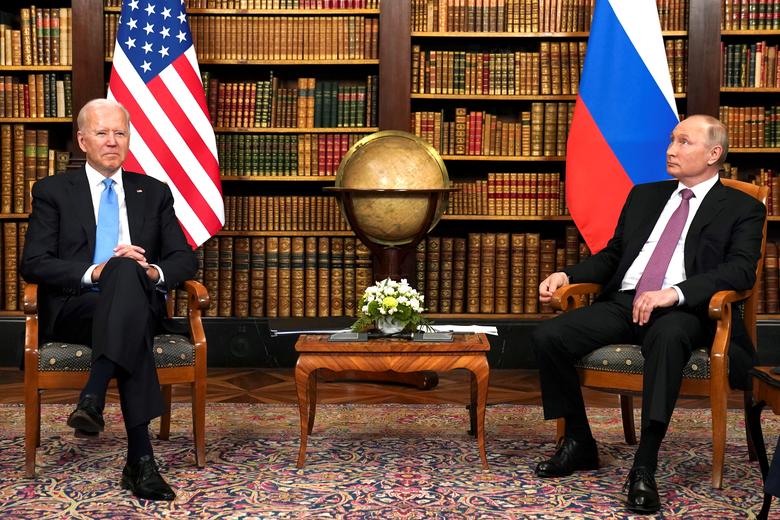Much speculation surrounded the lead up to the just concluded summit in Geneva between US President Joe Biden and his Russian counterpart, Vladimir Putin.
Coming after a NATO meeting where Biden reaffirmed his commitment to preserve Ukraine’s territorial integrity and sought to bolster the alliance against information warfare, it would have been fair to anticipate a relatively bellicose stance from the American leader.
By the same token, Putin had recently voiced some robust rhetoric that Russia would vigorously confront any threat to its sovereignty, alongside making a number of provocations, including massing troops on the border with Ukraine and lamenting the defeat of Donald Trump in the US presidential election.
All of this could have pointed to a feisty exchange between the two leaders.
In the end, the summit was a relatively calm affair. This was no doubt aided by the fact there were low expectations on both sides: they were merely hoping the hostile relationship could be ratcheted down a notch or two.
Despite the very low bar, it is likely both leaders marginally exceeded what they hoped to achieve.
The highlight was the announcement of a strategic dialogue between the two nations focused on arms control. That is comforting to an extent, but it was not a great stretch for either Putin or Biden to confirm that nuclear war was something each wished to avoid.
Arms control was already one of the few things Moscow and Washington could agree on — as witnessed by the New START nuclear weapons treaty extension that was concluded soon after Biden took office, at the height of tensions between the two leaders. So, there should be little enthusiasm this dialogue will break much new ground.
Instead, the key takeaway from the summit was that both the US and Russia remain determined to confront and compete with one another, albeit in a slightly more controlled way than the free-for-all of the Trump era.
A good indication of this was the identification by the US side of 16 components of critical infrastructure that it deemed off limits to Russian meddling. That was an interesting development in itself, since it thrust cybersecurity (which is key to the maintenance of critical infrastructure in an automated age) to the forefront on high-level, strategic interactions between adversaries.
In other words, the US is seeking to draw red lines in the so-called grey zone.
Putin is a winner just showing up
The main question from this is whether Putin is at all interested in the type of strategic stability the US has offered.
One could make the argument the Russian state is at its most effective in its rivalry with the West in general (and the US in particular) when it acts unpredictably and seeks to exacerbate existing divisions within and between states. It has also used a variety of instruments, from repression to energy diplomacy, to successfully bolster its image as a great power, albeit a capricious one.
In fact, Putin is already the winner from the summit simply by virtue of the fact the Biden administration agreed to it. Images of the two leaders adopting a relaxed posture, seemingly at ease with one another, does much to salve Putin’s need for recognition and status.
Domestically, it helps him show Russians that he is still influential globally. And internationally, it supports the Kremlin narrative that Russia should be treated as a leading pillar of an emerging multi-polar order.
Where to from here?
It is true both leaders scored points against one another. Biden’s references to the treatment of Russian dissident Alexey Navalny and his condemnation of Russian influence operations were tailored for his domestic audience.
These messages focused attention on US core values, which sharply distinguished his presidency from the messy transactionalism of Trump’s. It sent the same message to America’s allies, in an attempt to reassure them the US was once again prepared to lead on such matters.
For his part, Putin engaged in some customary “whataboutism” when chiding the US as hypocritical in castigating others but not looking to its own deep internal problems. And given the opportunity in an NBC interview to deny he was a “killer”, as Biden had labelled him in March, Putin quite deliberately didn’t take it.
Ultimately, the Biden-Putin summit was certainly not a full “reset” of the relationship. Yet, neither was it an attempt to simply hit snooze on it, with Putin extracting concessions from Washington while Biden pauses US confrontation with Moscow to focus on the bigger challenge of a rising China.
Whether it is truly successful in returning some strategic stability to the relationship, though, will not be clear for some time. If Russia-US relations slide back into chaotic competition, at least Biden can say he tried.
And for his part, Putin will likely hint that he didn’t.



 Colombia’s Clan del Golfo Peace Talks Signal Mandatory Prison Sentences for Top Leaders
Colombia’s Clan del Golfo Peace Talks Signal Mandatory Prison Sentences for Top Leaders  Australia’s Under-16 Social Media Ban Sparks Global Debate and Early Challenges
Australia’s Under-16 Social Media Ban Sparks Global Debate and Early Challenges  Environmental Group Sues to Block Trump Image on U.S. National Park Passes
Environmental Group Sues to Block Trump Image on U.S. National Park Passes  New Epstein Photos Surface Showing Trump as Lawmakers Near Document Release Deadline
New Epstein Photos Surface Showing Trump as Lawmakers Near Document Release Deadline  Trump Administration Unveils High-Priced “Trump Gold Card” Visa Program
Trump Administration Unveils High-Priced “Trump Gold Card” Visa Program  Ukraine, US and Europe Seek Unified Peace Framework With Security Guarantees for Kyiv
Ukraine, US and Europe Seek Unified Peace Framework With Security Guarantees for Kyiv  Air Force One Delivery Delayed to 2028 as Boeing Faces Rising Costs
Air Force One Delivery Delayed to 2028 as Boeing Faces Rising Costs  International Stabilization Force for Gaza Nears Deployment as U.S.-Led Planning Advances
International Stabilization Force for Gaza Nears Deployment as U.S.-Led Planning Advances  Thailand Moves Toward Early Elections After Parliament Dissolution
Thailand Moves Toward Early Elections After Parliament Dissolution  Indonesia–U.S. Tariff Talks Near Completion as Both Sides Push for Year-End Deal
Indonesia–U.S. Tariff Talks Near Completion as Both Sides Push for Year-End Deal  Trump Signs Executive Order to Establish National AI Regulation Standard
Trump Signs Executive Order to Establish National AI Regulation Standard  Brazil Arrests Former Peruvian Foreign Minister Augusto Blacker Miller in International Fraud Case
Brazil Arrests Former Peruvian Foreign Minister Augusto Blacker Miller in International Fraud Case  Japan Weighs New Tax Breaks to Boost Corporate Investment Amid Spending Debate
Japan Weighs New Tax Breaks to Boost Corporate Investment Amid Spending Debate  U.S. Lifts Sanctions on Brazilian Supreme Court Justice Amid Shift in Brazil Relations
U.S. Lifts Sanctions on Brazilian Supreme Court Justice Amid Shift in Brazil Relations  Trump Signals Conditional Push for Ukraine Peace Talks as Frustration Mounts
Trump Signals Conditional Push for Ukraine Peace Talks as Frustration Mounts  Preservation Group Sues Trump Administration to Halt $300 Million White House Ballroom Project
Preservation Group Sues Trump Administration to Halt $300 Million White House Ballroom Project 






























